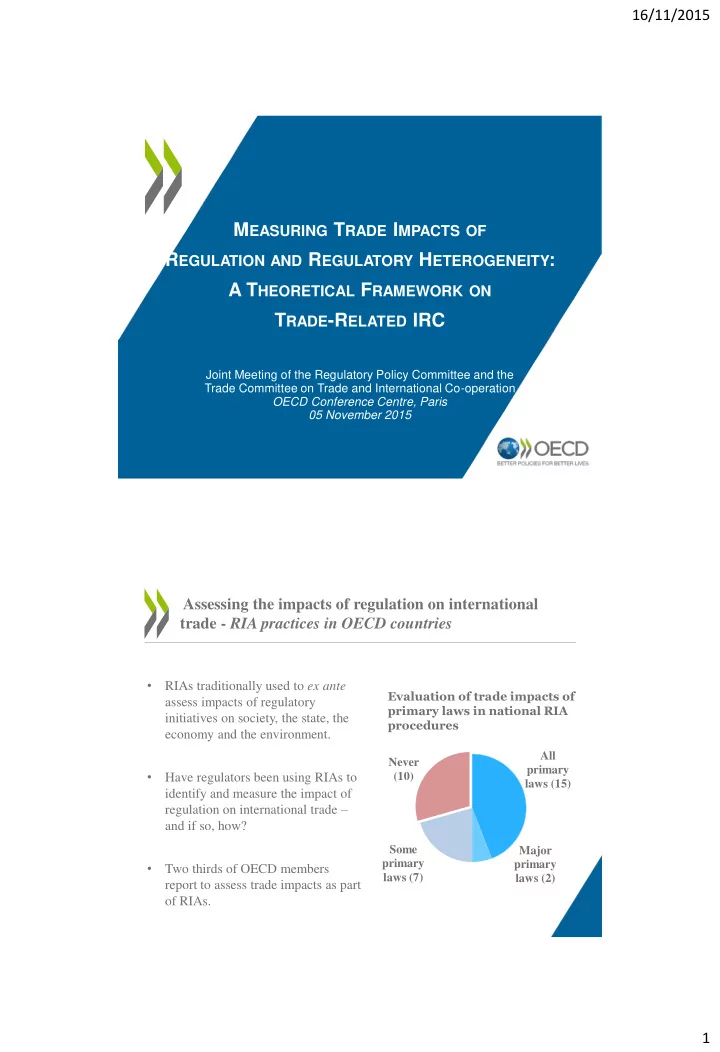

16/11/2015 M EASURING T RADE I MPACTS OF R EGULATION AND R EGULATORY H ETEROGENEITY : A T HEORETICAL F RAMEWORK ON T RADE -R ELATED IRC Joint Meeting of the Regulatory Policy Committee and the Trade Committee on Trade and International Co-operation OECD Conference Centre, Paris 05 November 2015 Assessing the impacts of regulation on international trade - RIA practices in OECD countries • RIAs traditionally used to ex ante Evaluation of trade impacts of assess impacts of regulatory primary laws in national RIA initiatives on society, the state, the procedures economy and the environment. All Never primary • Have regulators been using RIAs to (10) laws (15) identify and measure the impact of regulation on international trade – and if so, how? Some Major primary primary • Two thirds of OECD members laws (7) laws (2) report to assess trade impacts as part of RIAs. 1
16/11/2015 Assessing the impacts of regulation on international trade - RIA practices in OECD countries (cont’d) • What do countries’ trade impact measurement in RIAs focus on? 1. Macroeconomic effects 2. Impacts on ex- and imports 3. Impacts on third countries 4. Interactions between domestic and international regulation • De facto limitations in the use of RIAs to assess trade impacts 1. Problem with RIA overload 2. Vagueness of guidelines yet limited expert involvement 3. Focus on impact of regulation, not of regulatory divergence 4. Focus on domestic impacts, not international impacts (GVCs) 5. Private standards (and related trade barriers) not subject of RIAs Assessing the impacts of regulation on international trade - RIA practices in OECD countries (cont’d) • Challenges and potential for improvement 1. Methodological challenges to measure and to quantify regulatory divergence 2. Strengthened focus on impacts on GVCs beyond national borders 3. Improved consultations between line ministry drafting RIA report and trade experts Ensure proportionality of assessment Accurately identify trade impacts • Complementary tools 1. Inherent limitations of RIAs 2. Stakeholder consultations on trade impacts 3. Ex post evaluation to measure trade impacts of regulation 2
16/11/2015 Benefits of Trade-Related IRC: Objective of a Theoretical Framework • Key question: – How, from a theoretical perspective, can reduced regulatory heterogeneity increase national (and international) welfare ? – In other words: how best to strike the balance between domestic regulatory objectives and the benefits of international trade? OECD Trade and Agriculture Directorate 5 Conceptual basis • Current focus on product and production requirements • Application of two key economic concepts: – Welfare theory – Game theory • Welfare problem can be split in two parts: – Domestic effects of regulation • Including the direct regulatory benefits and any domestic market effects arising from the regulation – Heterogeneity-costs (or trade costs) • Losses due to costs arising from regulatory differences OECD Trade and Agriculture Directorate 6 3
16/11/2015 From the acknowledgement of trade costs to adjusted regulation • Analysis of regulatory outcomes for different cooperation scenarios: – No information sharing : countries base their regulation only on domestic effects – Information sharing : countries‘ regulations in response to trade partners‘ regulatory activity – Negotiations : pareto-optimal regulatory outcomes – Optimal negotiation outcomes from an international perspective OECD Trade and Agriculture Directorate 7 Perspectives on the Implications for IRC Balancing relative importance of trade costs and domestic effects Accounting for trade costs generally should lead to less divergent regulations Heterogeneity-related trade costs relevant not only for exporters, but also for importers higher prices, reduced choice Addressing inefficiencies: information inefficiencies cooperation inefficiencies bundling inefficiencies OECD Trade and Agriculture Directorate 8 4
16/11/2015 Additional issues to be considered in the Theoretical Framework • Work in progress: current Theoretical Framework focused on changes in product and production requirements, but – Costs related to design and implementation of (changed) regulations – Costs related to conformity assessment and certification – Importance of fixed versus variable trade costs – Options for addressing heterogeneity-related trade costs without regulatory changes (e.g. MRAs) • Making the Framework practically useful – Prime purpose: support a future Diagnostic Tool – Ensure reality check OECD Trade and Agriculture Directorate 9 OECD Trade and Agriculture Thank you ! Contact: Robert.Basedow@oecd.org Veronique.Bastien@oecd.org Barbara.Fliess@oecd.org Celine.Kauffmann@oecd.org Martin.vonLampe@oecd.org 10 5
Recommend
More recommend